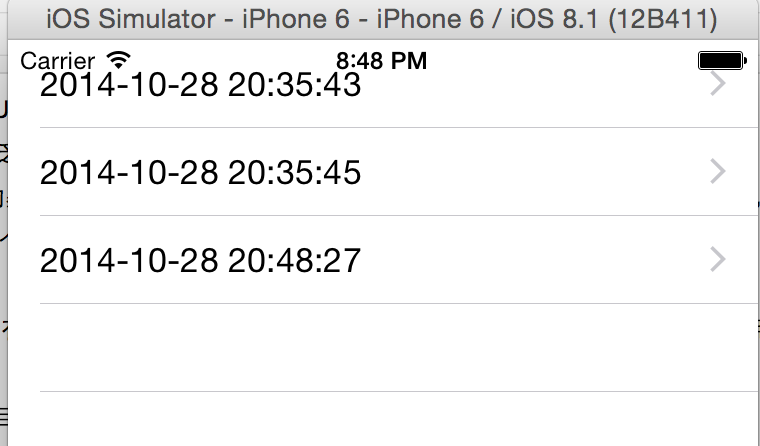IOS下实现UI下拉刷新功能
发布于 2014-10-29 09:18:56 | 856 次阅读 | 评论: 0 | 来源: 网友投递
iOS苹果移动操作系统
苹果iOS是由苹果公司开发的移动操作系统。苹果公司最早于2007年1月9日的Macworld大会上公布这个系统,最初是设计给iPhone使用的,后来陆续套用到iPod touch、iPad以及Apple TV等产品上。
本文为大家讲解的是ios开发中实现UI下拉刷新功能,感兴趣的同学参考下。
由于表应用有两个UI设计模式: 分页模式、下拉刷新模式。
其中下拉刷新被广泛应用(新浪微博,QQ)
这里吐槽一下QQ的墨迹,其实PC桌面的应用还好,及时的扁平化。但是IOS这么大的市场,但是现在都IOS8了,为什么还在用IOS6的下拉刷新的“胶皮糖”UI样式。
IOS6以后增加了一个UIRefreshControl的下拉刷新类,目前这个类只能应用于表视图界面。
在Xcode6中,还没有在故事版中增加下拉拖拽,类似label之类的控件。所以布局什么的不用太多考虑。
代码部分可重用,目前就当作一个库来用吧。

H文件:
#import <UIKit/UIKit.h>
@interface TableViewController : UITableViewController
@property (nonatomic, strong) NSMutableArray * Logs;
@end
M文件:
#import "ViewController.h"
@interface TableViewController ()
@end
@implementation TableViewController
- (void)viewDidLoad {
[super viewDidLoad];
// 初始化变量和时间
self.Logs = [[NSMutableArray alloc] init];
NSDate *date = [[NSDate alloc] init];
[self.Logs addObject:date];
// 初始化UIRefreshControl
// rc为该控件的一个指针,只能用于表视图界面
// 关于布局问题可以不用考虑,关于UITableViewController会将其自动放置于表视图中
UIRefreshControl *rc = [[UIRefreshControl alloc] init];
rc.attributedTitle = [[NSAttributedString alloc]initWithString:@"下拉刷新"];
// 一定要注意selector里面的拼写检查
[rc addTarget:self action:@selector(refreshTableView) forControlEvents:UIControlEventValueChanged];
self.refreshControl = rc;
}
- (void)didReceiveMemoryWarning {
[super didReceiveMemoryWarning];
// Dispose of any resources that can be recreated.
}
- (void) refreshTableView
{
if (self.refreshControl.refreshing) {// 判断是否处于刷新状态
self.refreshControl.attributedTitle = [[NSAttributedString alloc] initWithString: @"加载中..."];
// 添加新的模拟器
NSDate *date = [[NSDate alloc] init];
// 模拟请求完成以后,回调方法callBackMethod
[self performSelector:@selector(callBackMethod:) withObject:date afterDelay: 3];
}
}
- (void) callBackMethod:(id) obj
{
[self.refreshControl endRefreshing]; // 停止下拉刷新控件,回到初始状态
self.refreshControl.attributedTitle =[[NSAttributedString alloc]initWithString:@"下拉刷新"]; // 文本变回来
[self.Logs addObject:(NSDate *)obj];
[self.tableView reloadData];
}
#pragma mark --- UITableViewDataSource代码
- (NSInteger) numberOfSectionsInTableView:(UITableView *)tableView
{
return 1;
}
- (NSInteger) tableView:(UITableView *)tableView numberOfRowsInSection:(NSInteger)section
{
return [self.Logs count];
}
- (UITableViewCell *)tableView:(UITableView *)tableView cellForRowAtIndexPath:(NSIndexPath *)indexPath
{
// 这可以说是Cell部分最重要的代码段了
// 定义Cell,然后判断cellIdentifier是否重用
static NSString *CellIdentifier = @"Cell";
UITableViewCell *cell = [tableView dequeueReusableCellWithIdentifier:CellIdentifier];
if (cell == nil) {
cell = [[UITableViewCell alloc] initWithStyle:UITableViewCellStyleValue1 reuseIdentifier: CellIdentifier];
}
// 然后获取时间
NSDateFormatter *dateFormat = [[NSDateFormatter alloc]init];
[dateFormat setDateFormat:@"yyyy-MM-dd HH:mm:ss"];
// 然后更新cell
cell.textLabel.text = [dateFormat stringFromDate:[self.Logs objectAtIndex:[indexPath row]]];
cell.accessoryType = UITableViewCellAccessoryDisclosureIndicator;
return cell;
}
@end